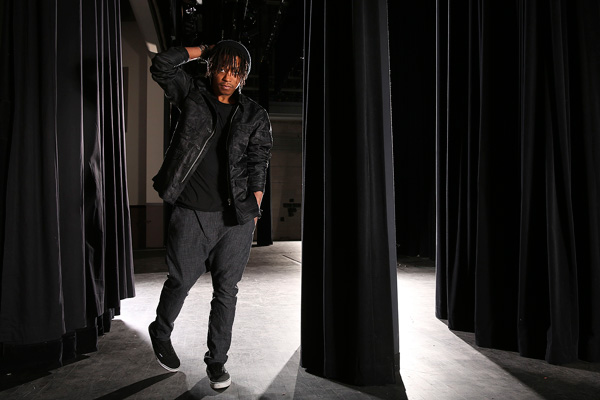
Photo: Chris Walker/Chicago Tribune
Lupe Fiasco at Thornton High School in Harvey, December 13, 2012
The other day, Lupe Fiasco—the 31-year-old rapper, West Side native, and graduate of Thornton Township High School in Harvey—made news with his speech to the Mass Black Male Graduation and Transition to Manhood Ceremony at Chicago State. Here's one way to describe it (Sun-Times):

Here's another, more arresting headline (Business Insider, of course):

Obliterates! That much is true, whether it was CPS specifically is not so clear:
Congratulations, you have graduated from one of the most terrible, substandard school systems in the entire world. You have just spent the last . . . 12 years receiving one of the worst educations on earth. You are at least four, five steps behind people in other countries that are younger than you.
Once upon a time, William Bennett decried Chicago's public schools as the worst in the country, though his "research guy," Chester E. Finn, Jr., told Bennett that Newark, St. Louis, and Detroit were all in the running for that title. Since then (emphasis mine), they've improved:
Chicago schools are not what they were in 1990. Graduation rates have improved tremendously, and students are more academically prepared than they were two decades ago. ACT scores have risen in recent years, and elementary math scores are almost a grade level above where they were in the early 1990s. However, average elementary school test scores remain well below levels necessary for doing college preparatory work in high school. High schools have little chance of preparing students for college when they enter ninth grade with extremely low skill levels. In fact, despite some improvements in test gains in the high schools, average high school test scores remain well below levels that indicate students are likely to succeed in college. This is not a problem that is unique to Chicago. Nationwide, the typical high school graduate also fails to perform at college-ready levels. Students with similar economic and ethnic backgrounds at other schools in Illinois actually tend to perform worse than Chicago students.
So maybe he's talking about schools in Illinois, not just Chicago. The city's NAEP (National Assessment of Educational Progress) scores are below average for all national public schools, slightly below average for large-city schools, and comparable to cities like it (Houston, Los Angeles, Philadelphia) while outperforming some large cities (Detroit, Cleveland). Though the city has fared poorly on an economic basis in recent years, it has done comparably well on NAEP scores.
It's a big-city American public school system, suffering from problems that many such systems share. So perhaps he meant to condemn American public education generally. Well….
Many Americans believe that students in the United States ranked number one in the world on international tests several decades ago and that after years of bad policies fell to the bottom of the pack. Typical is a September 2010 story in Newsweek magazine, which states, “U.S. students, who once led the world, currently rank 21st in the world in science and 25th in math.”
This is a myth. The United States never led the world. It was never number one and has never been close to number one on international math tests. Or on science tests, for that matter.
[snip]
In 1964, the United States ranked eleventh out of twelve countries, with a z-score of -0.35 [average is a zero, but the average is taken from a handful of first-world countries]. Only Sweden scored lower. Other grades were also tested, and the results for the United States were equally disappointing. Today, on both TIMSS and PISA, the United States does better, scoring close to average, with a z-score of -0.06 on TIMSS [Trends in Mathematics and Science Study] and -0.18 on PISA [Programme for International Student Assessment]. Among all participants on TIMSS and PISA, the United States scores slightly above average on TIMSS and slightly below average on PISA (when compared on PISA to OECD nations only).
Americans have long panicked about how our schools compare to the countries we're afraid of—it used to be the Russkies, now it's China. And there may have been more reason to worry then. Which is not to say that American or Chicago schools can't or shouldn't be better, but instead of a fall from some golden era of public education, Chicago schools face the burden of decades of problems: astronomic dropout rates, Willis Wagons, double-shifts that once deprived Chicago students of hours of schooling a day. Given how much education is passed down from one generation to the next, current efforts aren't just addressing the substantial needs of current students, but decades of underinvestment.


